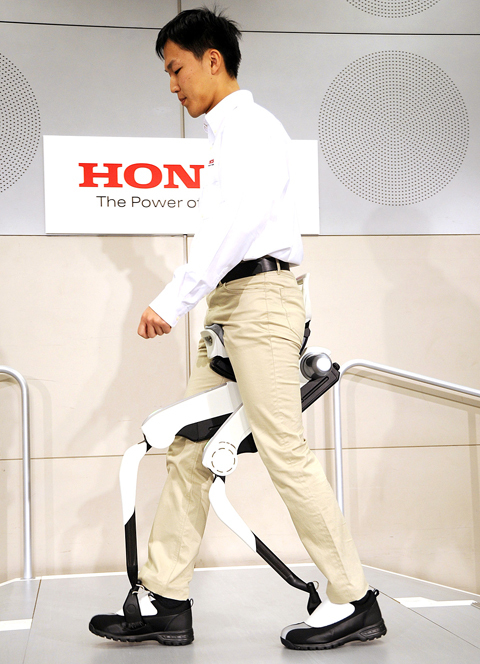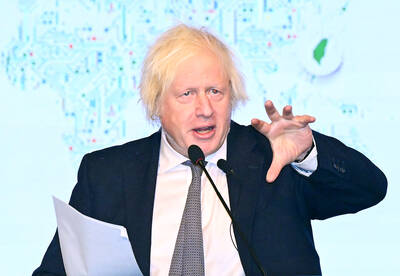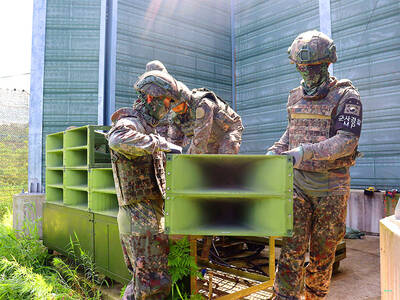Imagine a bicycle seat connected by mechanical frames to a pair of shoes for an idea of how the new wearable assisted-walking gadget from Honda works.
The experimental device, unveiled on Friday, is designed to support body weight, reduce stress on the knees and help people get up steps and stay in crouching positions.
Honda envisions the device being used by workers at auto or other factories. It showed a video of Honda employees wearing the device and bending to peer underneath vehicles on an assembly line.

PHOTO: AP
Engineer Jun Ashihara said the machine was also useful for people standing in long lines and for people who run around to make deliveries.
“This should be as easy to use as a bicycle,” Ashihara said at Honda’s Tokyo headquarters. “It reduces stress, and you should feel less tired.”
To wear it, you put the seat between your legs, put on the shoes and push the on button. Then just start walking around.
In a test-run for the media, this reporter found it does take some getting used to. But I could sense how it supported my moves, pushing up on my bottom when I squatted and pushing at my soles to help lift my legs when I walked.
The system has a computer, motor, gears, battery and sensors embedded in it so it responds to a person’s movements, Honda Motor Co said.
Pricing and commercial product plans are still undecided. Japan’s No. 2 automaker will begin testing a prototype with its assembly line workers later this month for feedback.
The need for such mechanical help is expected to grow in Japan, which has one of the most rapidly aging societies in the world.
Other companies are also eyeing the potentially lucrative market of helping the weak and old get around. Japan is among the world’s leading nations in robotics technology, not only for industrial use but also for entertainment and companionship.
Earlier this year, Japanese rival Toyota Motor Corp showed a Segway-like ride it said was meant for old people.
Japanese robot company Cyberdyne has begun renting out in Japan a belted device called HAL — for “hybrid assistive limb” — that reads brain signals to help people move about with mechanical leg braces that strap to the legs.
Honda has shown a similar but simpler belted device. It has motors on the left and right, which hook up to frames that strap at the thighs, helping the walker maintain a proper stride.
That device, being tested at one Japanese facility, helps rehabilitation programs for the disabled, encouraging them to take steps, Honda official Kiyoshi Aikawa said.
Honda has been carrying out research into mobility for more than a decade, introducing the Asimo humanoid in 2000.

Authorities have detained three former Taiwan Semiconductor Manufacturing Co (TMSC, 台積電) employees on suspicion of compromising classified technology used in making 2-nanometer chips, the Taiwan High Prosecutors’ Office said yesterday. Prosecutors are holding a former TSMC engineer surnamed Chen (陳) and two recently sacked TSMC engineers, including one person surnamed Wu (吳) in detention with restricted communication, following an investigation launched on July 25, a statement said. The announcement came a day after Nikkei Asia reported on the technology theft in an exclusive story, saying TSMC had fired two workers for contravening data rules on advanced chipmaking technology. Two-nanometer wafers are the most

Tsunami waves were possible in three areas of Kamchatka in Russia’s Far East, the Russian Ministry for Emergency Services said yesterday after a magnitude 7.0 earthquake hit the nearby Kuril Islands. “The expected wave heights are low, but you must still move away from the shore,” the ministry said on the Telegram messaging app, after the latest seismic activity in the area. However, the Pacific Tsunami Warning System in Hawaii said there was no tsunami warning after the quake. The Russian tsunami alert was later canceled. Overnight, the Krasheninnikov volcano in Kamchatka erupted for the first time in 600 years, Russia’s RIA

CHINA’s BULLYING: The former British prime minister said that he believes ‘Taiwan can and will’ protect its freedom and democracy, as its people are lovers of liberty Former British prime minister Boris Johnson yesterday said Western nations should have the courage to stand with and deepen their economic partnerships with Taiwan in the face of China’s intensified pressure. He made the remarks at the ninth Ketagalan Forum: 2025 Indo-Pacific Security Dialogue hosted by the Ministry of Foreign Affairs and the Prospect Foundation in Taipei. Johnson, who is visiting Taiwan for the first time, said he had seen Taiwan’s coastline on a screen on his indoor bicycle, but wanted to learn more about the nation, including its artificial intelligence (AI) development, the key technology of the 21st century. Calling himself an

South Korea yesterday said that it was removing loudspeakers used to blare K-pop and news reports to North Korea, as the new administration in Seoul tries to ease tensions with its bellicose neighbor. The nations, still technically at war, had already halted propaganda broadcasts along the demilitarized zone, Seoul’s military said in June after the election of South Korean President Lee Jae-myung. It said in June that Pyongyang stopped transmitting bizarre, unsettling noises along the border that had become a major nuisance for South Korean residents, a day after South Korea’s loudspeakers fell silent. “Starting today, the military has begun removing the loudspeakers,”